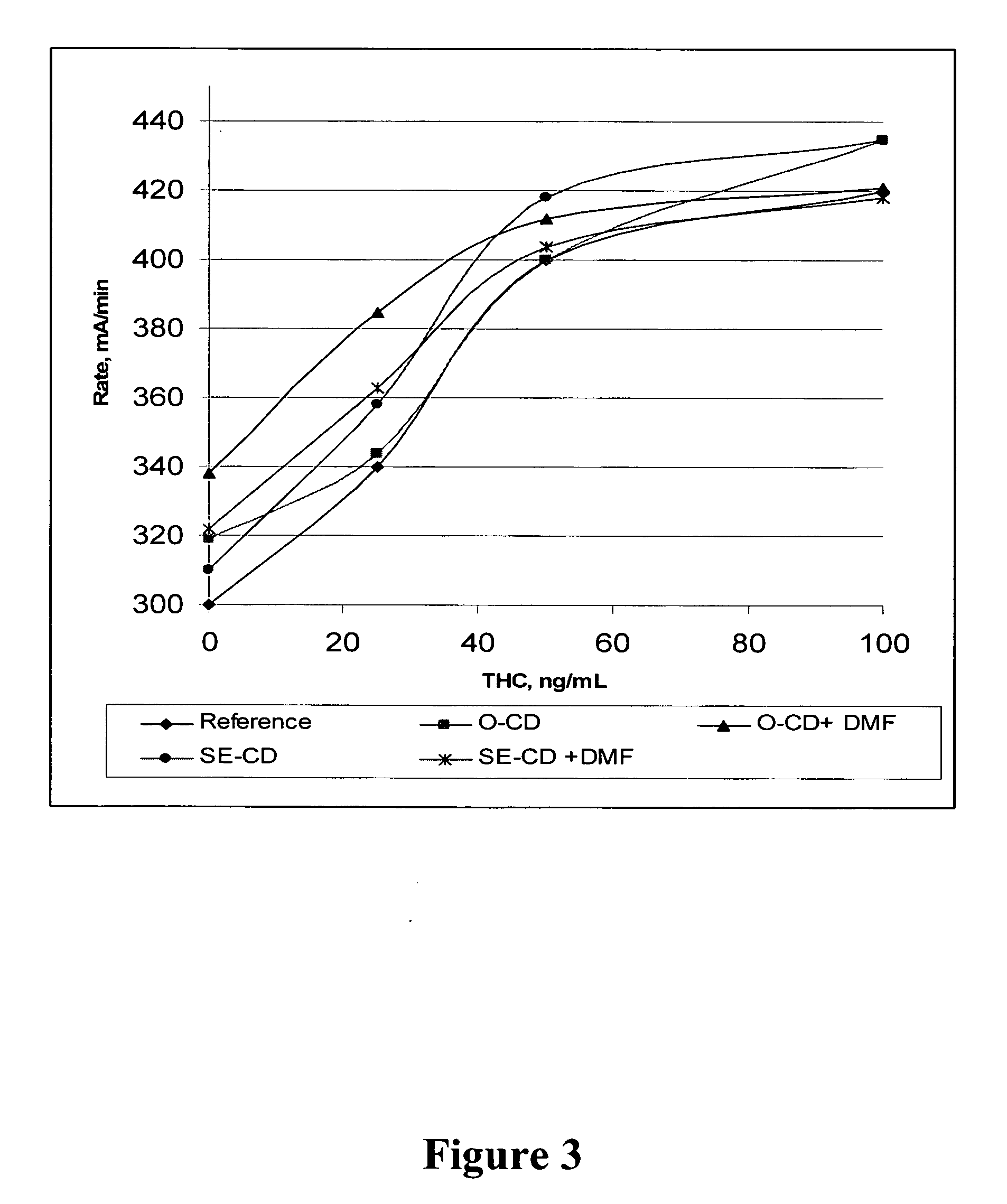Method for retrieving delta9-THC from oral fluid
a delta9thc and oral fluid technology, applied in the field of immunoassays, can solve the problems of increasing lung damage and emphysema, smoking marijuana increases the risk of cancer, and the debate over whether or not the potential health benefits of smoking marijuana outweigh the potential health benefits. , to achieve the effect of increasing the sensitivity of cannabinoid testing
- Summary
- Abstract
- Description
- Claims
- Application Information
AI Technical Summary
Benefits of technology
Problems solved by technology
Method used
Image
Examples
example 1
Δ9-THC Sticks to Solid Surfaces
[0263] The following experiment demonstrates the problem of cannabinoids, especially, Δ9-THC to adhere to surfaces of collection devices.
[0264] Artificial oral fluid samples (Sciteck) were spiked with Δ9-THC at 25 ng / ml and 100 ng / ml concentrations. Two (2) ml of the spiked oral fluid was adsorbed to an oral fluid collection device (cotton swab; obtained from Salivette, provided by Sarstedt, Inc., N.C.). The oral fluid cotton swab was stored in a refrigerator overnight.
[0265] The oral fluid sample was removed from the cotton swab by centrifugation and assayed using the THC oral fluid assay reagents on a Hitachi 717 instrument. The result of this glucose-6-phosphate dehydrogenase assay is shown in the following table:
Δ9-THC ConcentrationReferenceRecovered from swab 0 ng / ml (negative)320 mA / min319 mA / min 25 ng / ml350 mA / min321 mA / min100 ng / ml420 mA / min326 mA / min
[0266] Reference corresponds to spiked sample without adsorption to collection device. The...
example 2
Selection of Organic Solvents Not Interfering with G6PDH Homogeneous Enzyme Immunoassay
[0267] The following experiment is performed to identify organic solvents in an extraction buffer for retrieving a cannabinoid that do not significantly interfere with enzyme-based detection assays, especially not with a homogeneous enzyme immunoassay employing G6PDH.
[0268] A negative buffer (50 mM Tris, pH 7.2) was mixed with 15% (w / v) of DMF, 30% (w / v) DMF, 30% (w / v) DMSO, 30% (w / v) ethanol, and 30% (w / v) dioxane), respectively. The solutions were well mixed and stored in a refrigerator overnight prior to use. The extraction buffers were used as negative samples and assayed using the THC oral fluid assay reagents on a Hitachi 717 instrument. The result of this glucose-6-phosphate dehydrogenase assay is shown in the following table:
Buffer withRate (mA / min)No solvent32015% (w / v) DMF32830% (w / v) DMF32730% (w / v) DMSO31230% (w / v) ethanol31430% (w / v) dioxane303
[0269] The result indicates that the ...
example 3
Retrieving Δ9-THC from an Oral Fluid Collection Device Using Extraction Buffers Comprising an Organic Solvent
[0270] The following experiment is performed to demonstrate that certain organic solvents can retrieve a cannabinoid, especially, Δ9-THC, from a collection device having adsorbed the cannabinoid.
[0271] Artificial oral fluid (Sciteck) was spiked with various concentrations of Δ9-THC and adsorbed to a collection device (cotton swab) as described in Example 1. After centrifugation to remove the oral fluid sample, the semi-dry cotton swabs were treated with extraction buffers comprising the organic solvents as indicated below. The extraction buffer volume was equal to the volume of oral fluid spiked with Δ9-THC. After approximately 6 minutes, the extraction buffer was compressed out of the oral fluid collection device and into a Hitachi 717 instrument sample cup and assayed using the THC oral fluid assay reagents. The results were recorded as mA / min.
Buffer + OrganicRecoverySo...
PUM
| Property | Measurement | Unit |
|---|---|---|
| Molar density | aaaaa | aaaaa |
| Molar density | aaaaa | aaaaa |
| Concentration | aaaaa | aaaaa |
Abstract
Description
Claims
Application Information
 Login to View More
Login to View More - R&D
- Intellectual Property
- Life Sciences
- Materials
- Tech Scout
- Unparalleled Data Quality
- Higher Quality Content
- 60% Fewer Hallucinations
Browse by: Latest US Patents, China's latest patents, Technical Efficacy Thesaurus, Application Domain, Technology Topic, Popular Technical Reports.
© 2025 PatSnap. All rights reserved.Legal|Privacy policy|Modern Slavery Act Transparency Statement|Sitemap|About US| Contact US: help@patsnap.com



